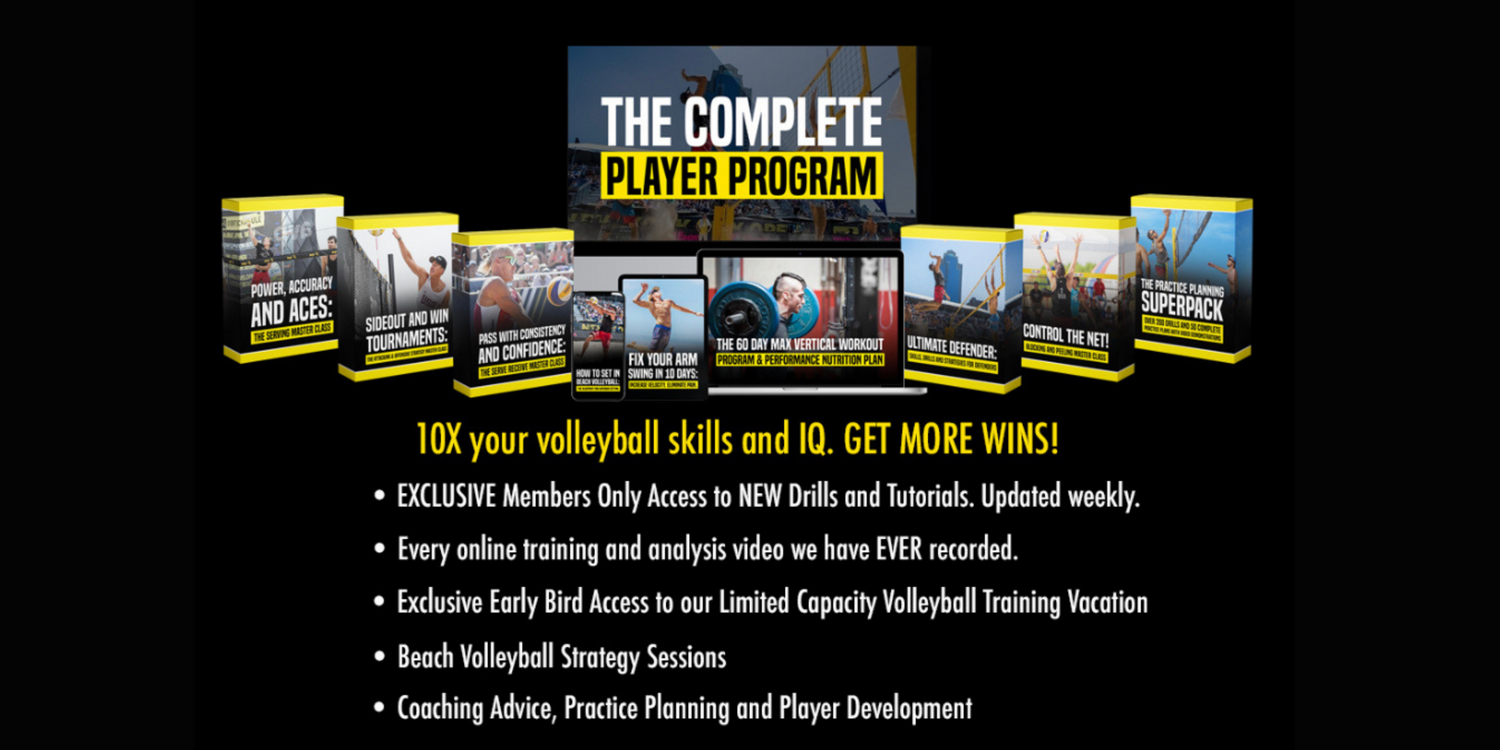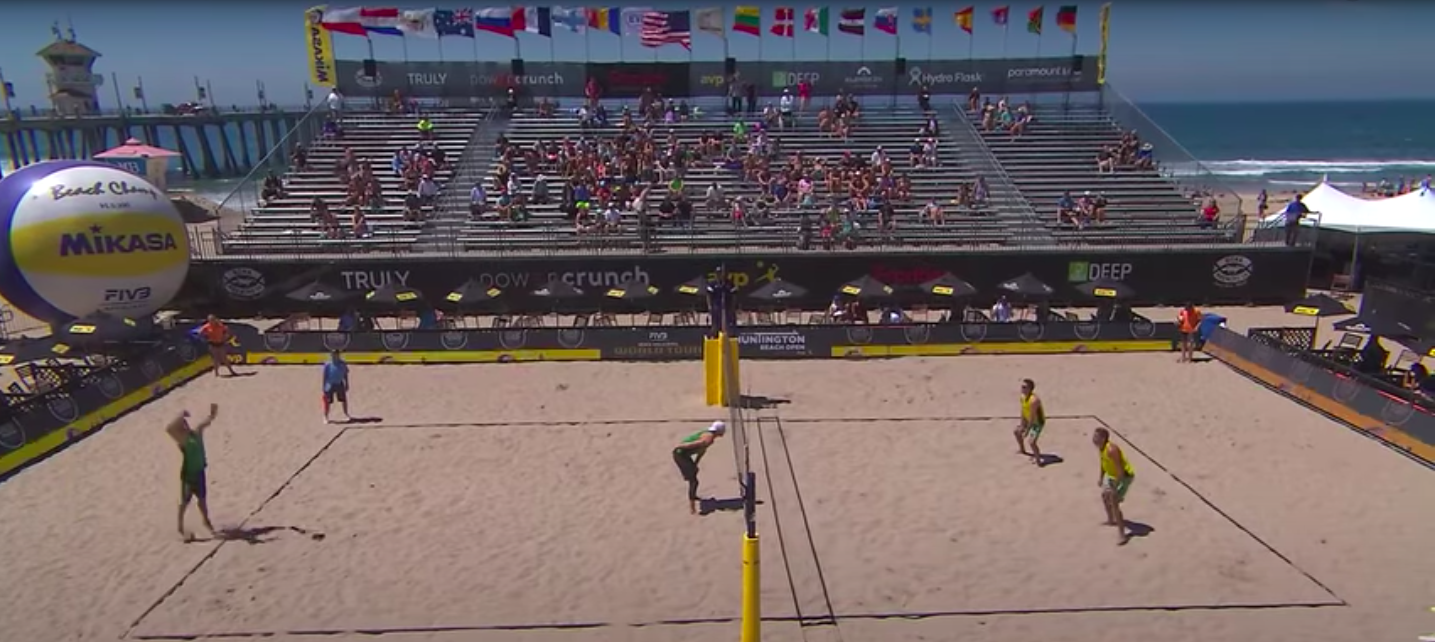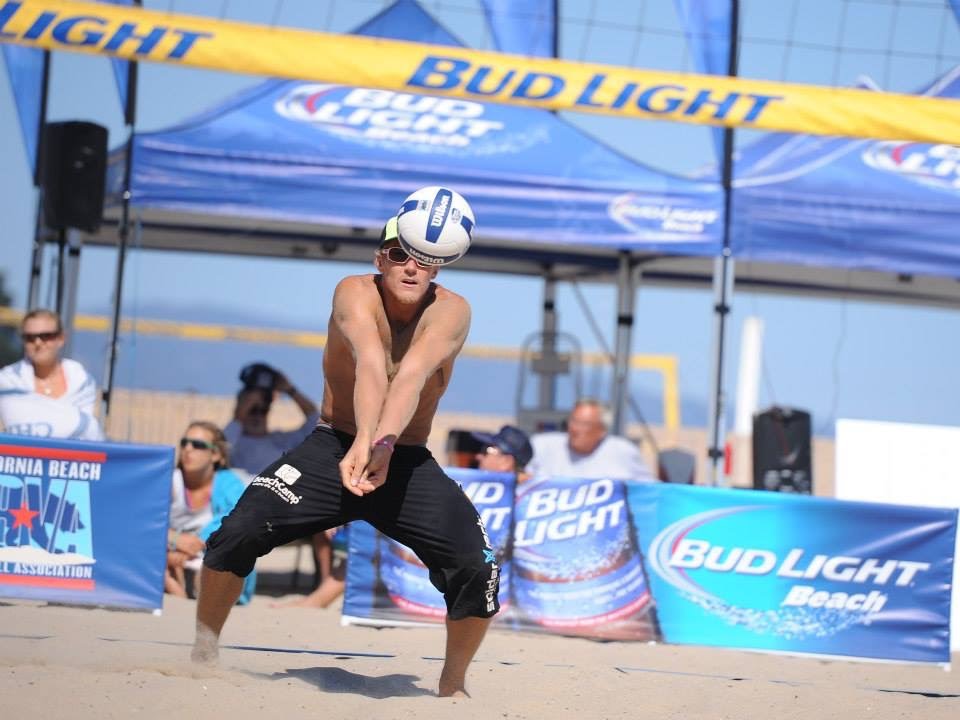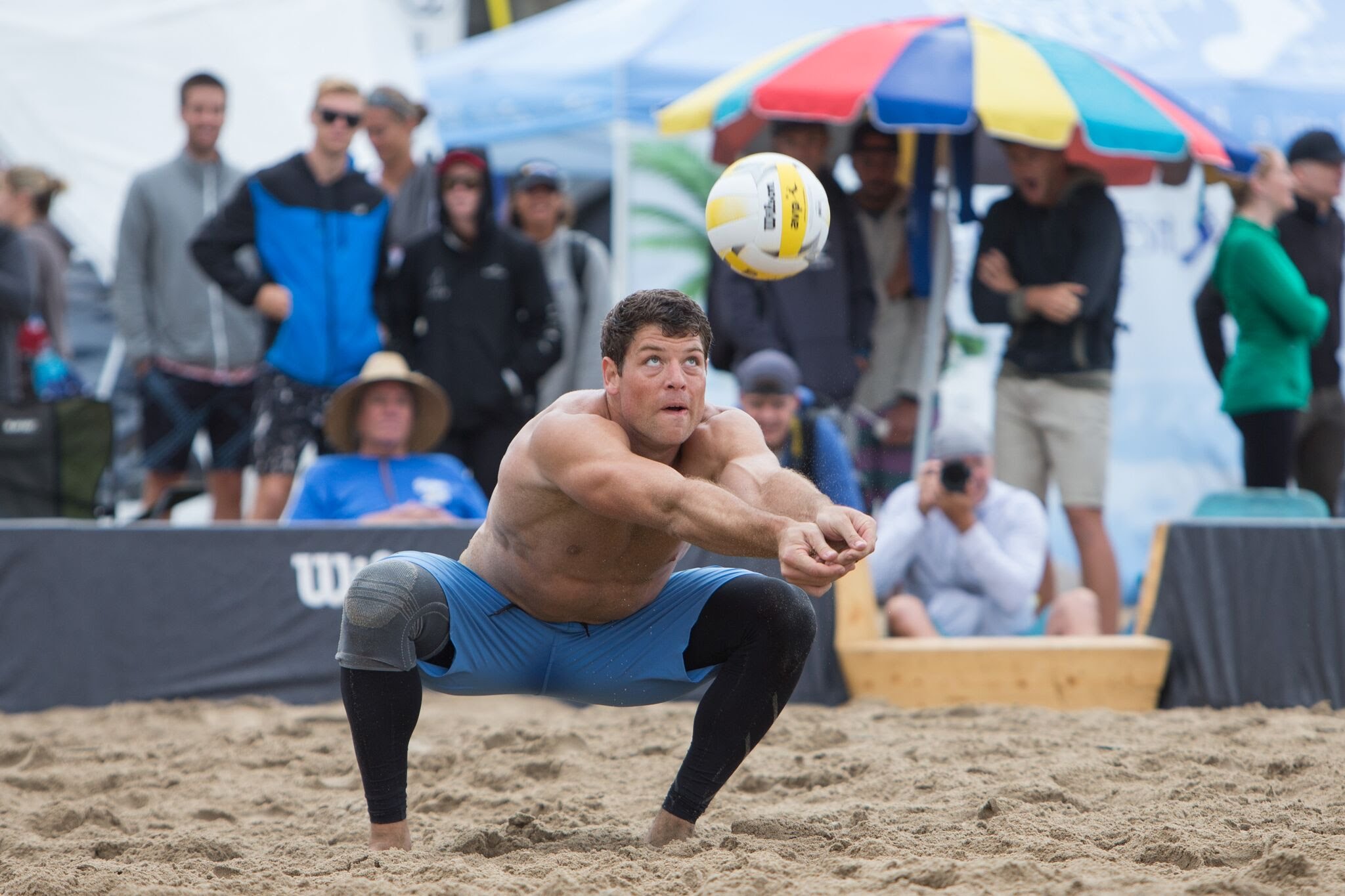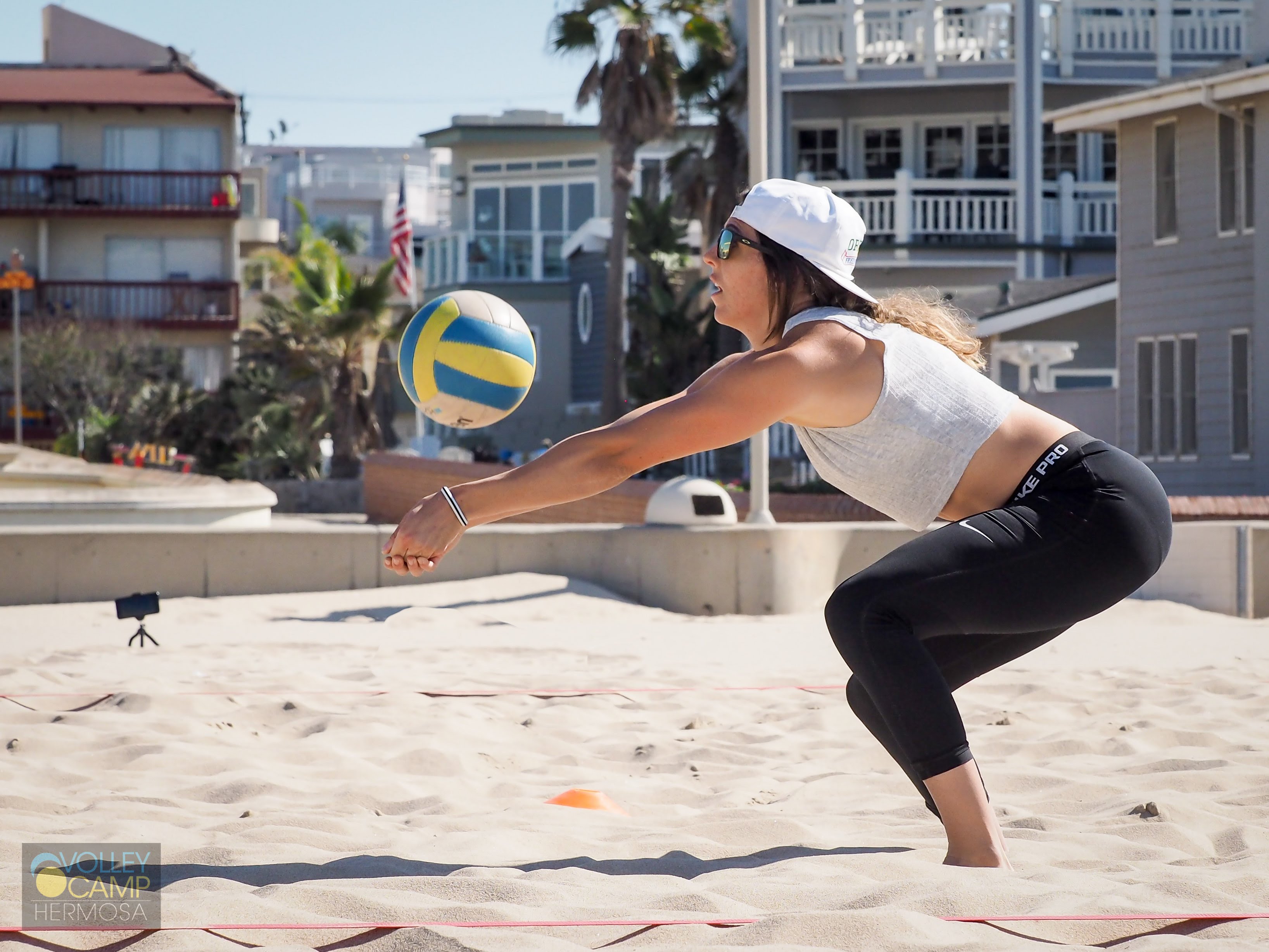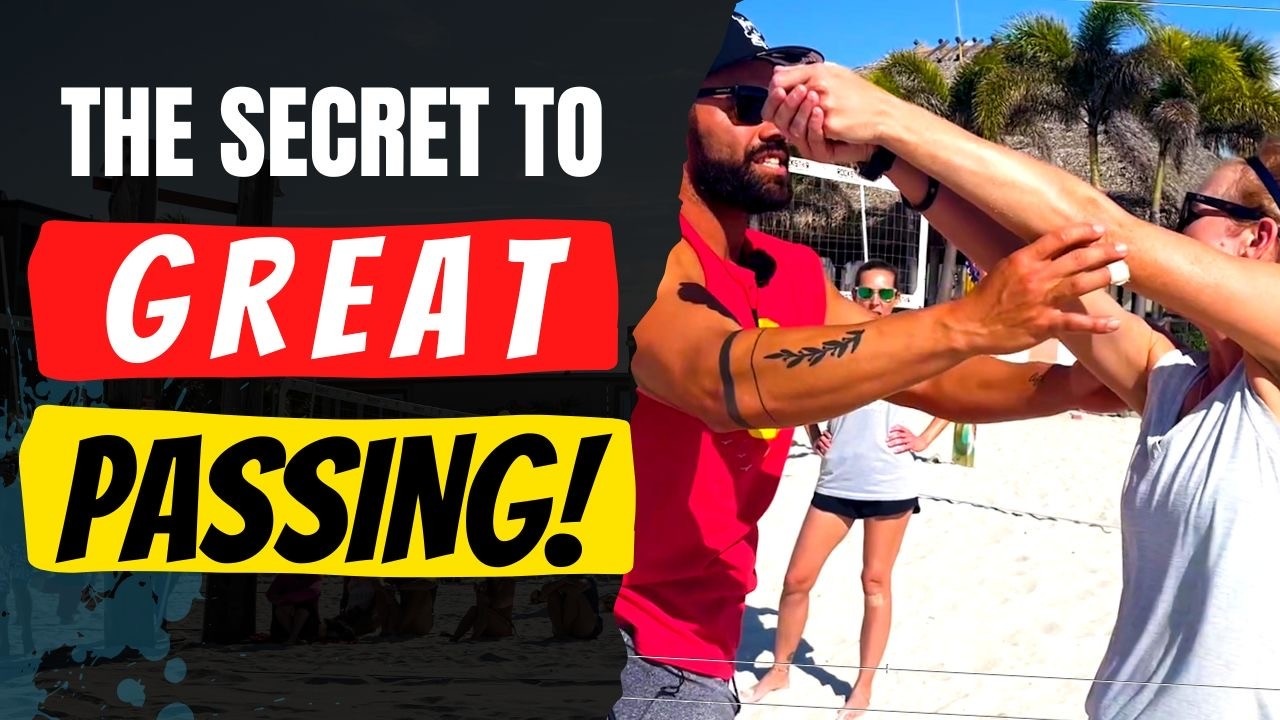
How to Master Passing in Volleyball- Beginner's Guide
Secrets to Passing in Beach Volleyball
Why can I not get the volleyball to my partner every time? Do you constantly find yourself chasing down balls because your pass went clear into outer space? No need to fret. We have you covered.
Whether you are looking to perfect your passing or starting your volleyball adventures, mastering the volleyball pass is crucial if you want to get better at playing beach volleyball. We will be covering a few basics to get you started to becoming the best beach volleyball player you can be and passing like April Ross and Phil Dalhausser.
While there are a few differences between passing for indoor volleyball and beach volleyball, we encourage everyone to use this information and add it to your arsenal.
What we are covering:
- Positioning - Where Should I Stand in Beach Volleyball
- Forearm Platform and Pass
- Passing Angles
POSITIONING - WHERE SHOULD I STAND IN BEACH VOLLEYBALL
Where Should I Stand on the Volleyball Court: Depth and Width
In beach volleyball when receiving the volleyball, both players should stand in the back fourth of the volleyball court -- three or four feet from the end line. After the proper depth, both players position themselves in the middle of their half of the court.
This leaves our players standing about 20 feet from the net and 6 feet from each sideline.
Why is this important?
We stand in the deeper part of the court for multiple reasons.
First, our natural height blocks balls from passing our bodies. Even if we were to stand at half court, it would take a high, arching ball to pass our bodies untouched.
Most serves (and attacks) will have a flatter trajectory so when we stand at that three-quarter-court depth, the majority of volleyball serves will cross the area from our shins to our shoulders, which is our passing sweet spot.
We also stand deeper in the court and side by side because we are naturally faster moving forward than we are moving backwards.
On the volleyball court, we can leave more space in front of us because we can get to a short ball faster than we can to a ball that would force us to move sideways or backwards.
Responsibilities of Each Player
There are multiple ways of divvying up responsibilities on the volleyball court.
In general, both players are responsible for their halves. There is no front and back in receiving a volleyball for beach volleyball. Both players are responsible for short and deep as they play side by side.
The number one problem partners need to talk about every play is who is responsible for the middle of the court also known as the “seam”. When the server serves between the two players, problems arise and arguments may occur. It is vital to have a discussion about this area before every single serve with a simple, “your middle” or “my middle.”
How to Change Your Passing Position in Different Wind Conditions
Side Wind
When there is heavy side wind, most knowledgeable players will set themselves up to serve into the wind. In heavy wind situations, receivers are quite vulnerable on the side the wind is coming from. If the wind is coming from the right, we don’t like to serve receive or play defense on the right side.
Again, the ball drops faster (if there is topspin) and moves more if there is a float (no spin) on the ball. It’s very difficult to chase a ball that is accelerating past you, so if the wind is on our left and the server is on our right, our team should shift left and angle our bodies towards the server.
Since players have to hit the volleyball softer when aiming with the wind, we will have more time to move to the ball if they serve our right sideline. It is best practice to shift one step to the left and defend the half of the court where the wind is coming from. In summary, it is best practice to place both receivers closer to where the wind is coming from.
Learn How to Pass a Volleyball from the PROs at our Vacation Training Camps in St Pete Beach.
We run volleyball vacations in exotic locations around the world. We can even run beach volleyball clinics for your group, club or team in your hometown! Send an email to [email protected]
Wind from the Front
When there is wind blowing towards our faces or coming from the opposite side of the net, the ball will carry a bit longer off of our opponents’ contact.
We are in our best attack position when the setter is in the front third of the court.
We should reposition ourselves to stand farther from the net so that we can stay behind the ball and PUSH it forward. Even the short serves will carry deeper than normal and hang in the air so don’t worry about being vulnerable there.
It’s better to stay far behind the ball so the receivers have the ability to really press the ball back into the wind. In summary, when the wind is blowing from the opposite side of the court, position your serve receive further away from the net.
Wind from the Back
In general, when the wind is at our back, we are considered to be on the “Bad Side” of the court. Float serves from the other team will move like crazy and topspin balls will dive down at the last second. I’ve always found it easier to step up closer to the net, sit extra low and keep my arms far in front of me.
This is a great way to get a good touch on a topspin serve. Since the ball is going to drop more vertically at the end of its flight, we can wait under it with a platform angle that is facing upward.
The wind from our back will carry the ball to the front of the court for us. If our angle is facing in the normal angle forward, the wind will add to the speed of the ball going forward and carry it tight to the net or worse onto the other side of the court.
In high winds, it takes an immense amount of strength to hit a topspin ball into the wind and to the back third of the court. In general we don’t have to worry about that shot.
In summary, when the wind is at your back, move closer to the net. We cover more about this and special situations in our blog - How to Pass a Volleyball - Special Situations.
POSTURE WHEN PASSING
The importance of the “Athletic Position” in beach volleyball is wholly and completely understated.
Your foot position, knee bend, glutes and core activation combined with your hand and arm position all play massive roles in your ability to initiate movement and get to the ball efficiently so that you can make a clean, smooth contact.
In other words, you need to be in the athletic position in order to make the perfect pass. You can take all the lessons and all of the drills in the world that teach you how to pass a volleyball, but if your posture fails you, you’ll never reach your max potential.
To assume the athletic position for volleyball, place your feet JUST outside shoulder width. Too wide or too narrow and your balance and quickness will be dramatically decreased. Once you have your width set, bend your knees and push your butt back. You should be able to lean on your knees. This should put you in a quarter squat. Starting in another position will cause a slow initiation of movement.
Your core should also be engaged. This is a difficult concept to comprehend and master without elite coaching but if your spine isn’t rigid, your torso will wave when you move. This means that your lower body will move and it will take some time for your upper body to catch up and stabilize.
If your core is not activated and rigid, you will be slow. A slow volleyball player is an unsuccessful one.
Finally, lock your elbows straight and keep your hands down. This should lead to one, efficient movement to the appropriate angle when passing. If your hands start out wide, or too far up, you will have to bring them together and down and then into the angle you need.
Start with your hands close together and down, with your elbows locked. It will feel robotic at first but it will lead to efficiency of movement.
Now that you’ve mastered the basic serve receive positions in beach volleyball, it’s now time to learn about making the perfect pass—how you can pass the ball to your setter so you can launch your attack.
FOREARM PLATFORM AND PASS
The Perfect Platform
Hand Build - Squeeze. Thumbs and Thumb Joints Kiss
Place your left hand out, palm up, with your fingers together. Now lay the fingers of your right hand (palm up) on top of the left hand fingers. Make sure the fingers of each hand run perpendicular to each other.
Now, squeeze your right fingers between your left thumb and left fingers. Bring your right thumb directly next to it. The sides of your thumbs and the heels of your palms should all be touching and symmetrical.
Why An Early Platform Is Important
There are a few things that stand out when players are learning how to bump a volleyball properly. These are passing mistakes in beach volleyball that most people make. Beginners who are just learning how to bump a volleyball make this mistake blatantly but a lot of veterans, who think they have their passing and serve receive dialed in, still don't get this 100% right.
One of the biggest passing mistakes has to do with what leads into inconsistent forearm passing and forearm setting. The important part that we need to remember when learning how to bump in volleyball is to have a platform that is simple and rigid. Your arms are not two arms with elbows anymore! Everything should come together, acting as one solid platform. When the ball bumps your forearms, it hits one flat, even surface.
A lot of players will approach to bump a volleyball and they'll shoot their elbows out at the very end. This is bad news.
(Editor's Note: You're going to have to start calling it "passing" or "serve receive" if you want to be in the volleyball cool club.)
Watch below as Mark shows how to build your platform early and stay strong.
So now they've made a passing platform that only gets solid at the end. This leads to overpasses and an inconsistent angle that we can't study. Remember that if you are going to bump a volleyball, your partner needs a steady surface to look at.
So, it is important to build early and hold long. When approaching a ball, we’d like to make sure that our hands are out of the way before we get to the ball so that we have a nice platform built and set up already. It might feel robotic at first, when you learn how to bump a volleyball like this, but the consistency will outweigh the discomfort.
Advantage Of Setting Up Early
When your beach volleyball partner (or even your setter for indoor volleyball) is looking at your platform, as well as looking at the volleyball flying towards your platform, they can easily predict where the ball is going to end up. If your partner sees that you’re preparing to bump or pass the volleyball and you are holding your platform still, they will have a clear visual of the ball approaching you. This allows them to get a head start and know where the direction of the ball will go next after hitting your platform.
However, if we have a moving platform hitting another moving object – which is the volleyball -- it becomes a lot more difficult for our partner to assess the situation. When learning how to pass in volleyball, one of the reasons we build an early and long platform is that it helps our partner out. They will know where the ball is about to fly.
Want to show your support and help us make more content?
Check out one of our Favorites...
 |
 |
|---|---|
| Crew Socks | Franklin Sports Ball Pump Kit |
Study Your Platform And Execute It The Right Way
Occasionally, beach volleyball players will set up their elbows bent and get a toss, then they'll shoot their elbows out. Some hide their hands while waiting and then abruptly set up their platform. This late movement creates platforms only for a moment. Some of these still end up as good passes, but again it will not be consistent because we have a moving object going at something that's traveling at varying speeds. Especially when you're just starting to learn how to bump a volleyball, we recommend you build your platform nice and early so that you're locked out and you make a simpler, more fluid motion.
Learning how to pass a volleyball can be a lifelong journey. If you don't have a coach around, or even if you do, you can record yourself at home or at practice to see if your elbows are straight before the ball gets to you. One of the most important things you can do to get better at passing for indoor volleyball or sand volleyball is to make sure that you build your platform early, hold it long and finish through the ball. This will increase your passing and setting efficiency.
You can record from the exact same angle on our video, or you can have anyone take a mobile phone, record you from the side and in a few seconds, you can study yourself to see if you're doing it exactly right. We encourage you to do this and see where you can make adjustments.
Straight Elbows
Once you have your hands built, lock your elbows out so they are straight. Your arms are no longer arms.They will now operate as one single unit, one single unbending, uncompromising platform.
They are inseparable.
Shoulder Shrug
A lot of beginners see other players who can make their elbows touch and get discouraged when they can’t get into that position.
First, not every player can line up their forearms so that there is no space between them and that is OK! We just want to get them as close together as possible.
There is also another trick that can get the arms closer together and comes with a few benefits we can talk about later. Straighten both arms and lift them up and in front of you. Imagine trying to touch your shoulders to your cheekbones. This should create a protracted and shrugged shoulder position. You can drop your hands lower but keep the shoulders shrugged.
This reshaping of the shoulder girdle allows the elbows and forearms to get closer together. It takes some getting used to but for a lot of people, getting their arms close together is impossible when their shoulders stay down and back in every day “good posture”.
Try it for yourself.
Try to build your platform with your shoulders down and back and see how far apart your arms are. Then, shrug and protract (push forward) from your shoulders and see if you close some space.
Firm
In order for the ball to bounce consistently and effectively off of our forearms, we need to be firm from our lats all the way through our hand grip.
If your elbows are permitted to bend, your wrists curl or your hands rattle at all, the ball will bounce differently off of your arms every time you touch it.
You don’t want to be flexing so hard that you are immobile but you must be firm through contact.
Early & Long
There is a long-standing fallacy that volleyball players cannot move effectively with their hands together or platforms built.
Coaches around the world can be seen putting on a cartoon-ish demonstration of how ridiculous it would look to be running with your arms locked out and together. This is simply an over-application of a biomechanical truth.
You can run faster when your arms pump. However, beach volleyball players don't really run much. We shuffle or take a maximum of two steps and a dive to get to any ball unless it is a complete shank that we have to chase down.
Only the absolute shortest and sharpest short serves would require forcing a running action in serve receive. We'll get to that later.
For now, we are going to take lessons from accuracy sports like archery and skeet shooting. When tracking a moving object, we should lock on to our target early.
You would not see an archer look at a moving target for a long time and then at the last possible moment, load his arrow, pull back and let it fly.
Accuracy requires early preparation and the final action involves next to no movement. As soon as the receiver knows where the ball is flying, they should build their platform and get the angle as close as possible to the finish position. Whether you are stable or on the move makes no difference.
This will not lead to shanks. This will not cause you to be so slow you can’t get to the ball. The accuracy that you gain from getting your platform and angle built will more than make up for any speed you lose on running, an action, which again, would be required on less than 5% of serves. When players attend my "Beach Volleyball for Beginner's" classes in Hermosa Beach, California, we spend a lot of time learning how to bump a volleyball with proper technique. Beginners often need to keep their hand grip so they don't forget how to shape them. While a lot of coaches frown on this, I love it. After a few volleyball lessons, I'll teach them how to separate their hands when necessary but personally, I'm not a fan of players putting their hands together at the last second. Most of the best passers and liberos in the world have their hands together before the ball even crosses the net.
Along the same vein of building your platform early, we should also be holding on to the build and the angle after the pass. One of the most common errors passers make is unlocking their platform right on contact.
Do not release on contact. Do not pull the arms away as soon as you touch it. Finish through the contact and make sure your platform is still intact after the contact. If you drive this home it will not only calm you down but it will prevent you from having a loosely built platform which leads to getting aced.
Bottom Rib Tuck and Airing Out the Armpits
During serve receive and passing in general, it’s important to keep the ball in your visual field for as long as possible and it’s important to have “adjustment space”.
“Bottom Rib Tuck” and “Air Out the Armpits” are two of the most effective visuals that have helped hundreds of players over the years. I personally use the “Bottom Rib Tuck” as a reminder during every tournament I compete in.
When our hands and elbows stay close to our torso, we struggle to move our platform fluidly and freely. Our platform basically gets tethered to our spine which is not very mobile or flexible. When the elbows stay away from our rib cage, it’s easier to prevent ourselves from getting jammed.
Once the ball gets too close to our stomach or chest, there is no more space or time to make a good pass. Demanding that a player keeps their rib cage from flaring up also forces them to move their feet better without saying anything about the feet.
Get your hands out. Keep the ball in front of you with your bottom rib tucked. This will keep your shoulders forward and create plenty of space for last-second adjustments and power absorption.
It’s a posture, not an action.
Hudson Bates has his armpits "aired out". If you wanted you could tickle the pits of that big AVP pro. If you're learning how to pass a volleyball, don't squeeze this area. Thinking about this should help you keep your hips back and your hands away from your body.
PASSING ANGLES
When most players start out, they imagine that a “bump” or a pass is a hit or, in other words, an active action on the ball.
In some cases, this is almost true, but we can get to that next.
For now, we need to understand that a ball coming from the opposite service line already has a lot of kinetic (moving) energy. If we have a well built, firm, platform, we only need to present it at the perfect angle and let the ball bounce off. So in actuality, you're not bumping the volleyball, you're just sitting still and firm while the ball comes and bumps you.
If you set up a few sheets of wood at a 30-degree angle where the serve receivers stand and served at them. The ball would bounce up and back to a good distance from the net without any “action.” Most serves have enough velocity for us to leave our angle in the perfect spot and let the ball bounce off.
The video below shows one of our coaches, aka Chaddy Daddy, at our training camp in St. Pete Beach giving a private lesson to two of our campers about how to use the best platform and angle for passing in volleyball.
A visual I like to use is when the sunlight hits your wristwatch through the window and you can see the bright reflection. If you want to aim the reflection and bother someone by shining it in their eyes, you wouldn’t make a violent move with your wrist and “throw” the sun rays in the direction of their retinas.
Instead, you would hold your wrist at just the right angle and allow the sunlight to bounce off your watch and into the desired location of your annoying big brother’s eyeball.
The exact same thing should happen when you're passing in beach volleyball. Find the right firm angle that calibrates for spin and speed and then let the ball bounce off it.
Speed and Power Considerations
There are instances of course when we have a ball that has not been hit very hard at all.
There is not enough kinetic energy for the ball to get to your setter. It is in these cases, where coaches all over the world get caught up in the use of legs or arms to add power to the ball.
The answer, as with most things, is somewhere in the middle.
We don't want to use a full depth squat thrust to get the ball high enough. This alters our brain’s interpretation of our visual field and makes it more difficult to accurately predict the flight of an object traveling at us.
We don't want to create a big swinging motion with our arms because that would go against our understanding of accuracy discussed in the first section. Instead, we want to give the ball just enough extra energy to get into our setter's hand.
Too much movement and we lose consistency and accuracy. Too little and the ball falls short. The energy can come from a forward rock. An added nudge from the arms or a very slight extension of the knees.
The important thing to remember is that simpler movements are easier to repeat and fix in the long run.
The following is a great video by the Mckibbin Brothers where Chaim Schalk talks more in depth on touch.
Learning how to bump in volleyball (or as you now know, "how to pass") makes the game a lot more fun. Improving your passing and serve receive skills will greatly improve the way you perform on the court. If you want to continue mastering skills, check out our blogs about basic footwork for passing in beach volleyball.
HOW TO PASS A VOLLEYBALL - BASIC FOOTWORK AND MORE

